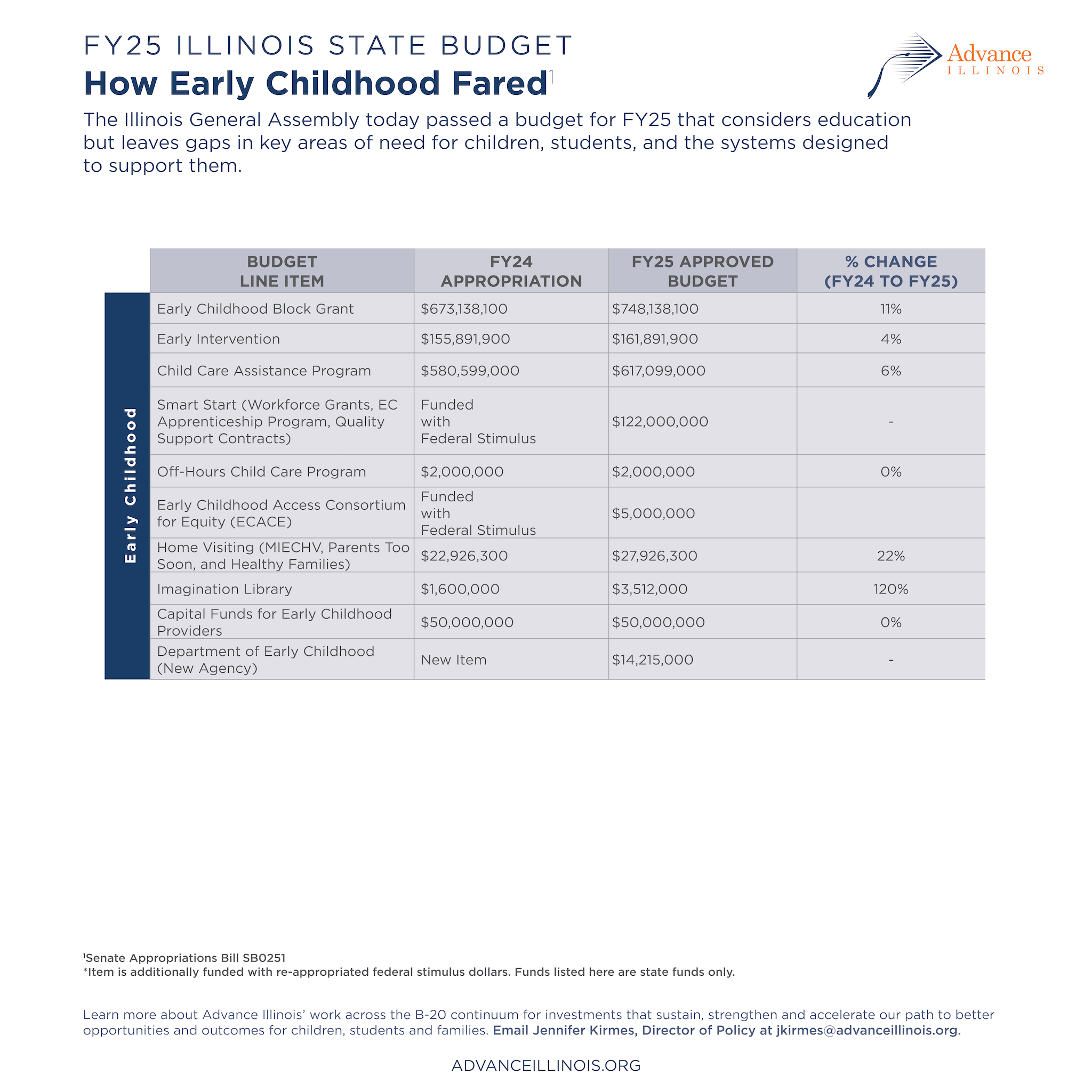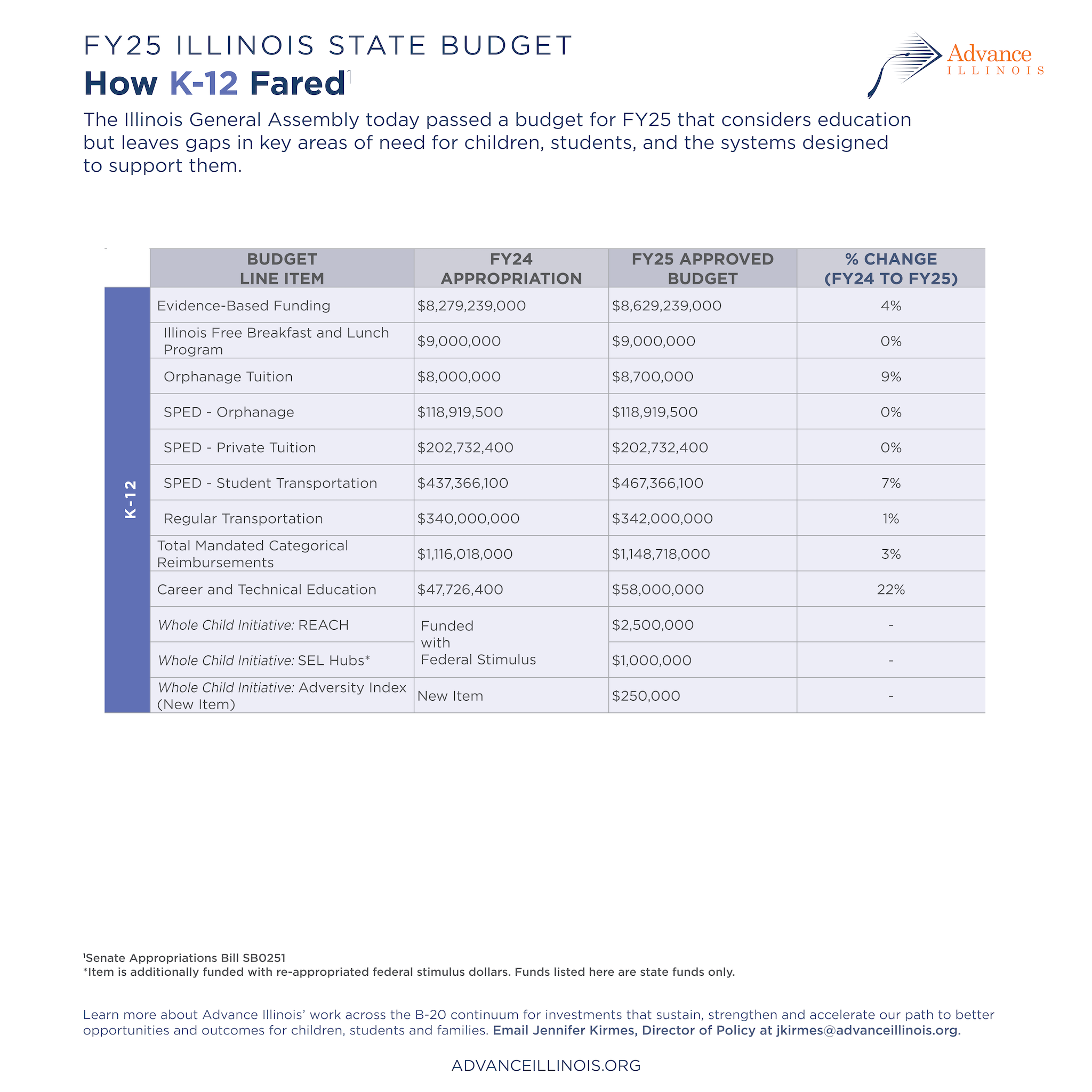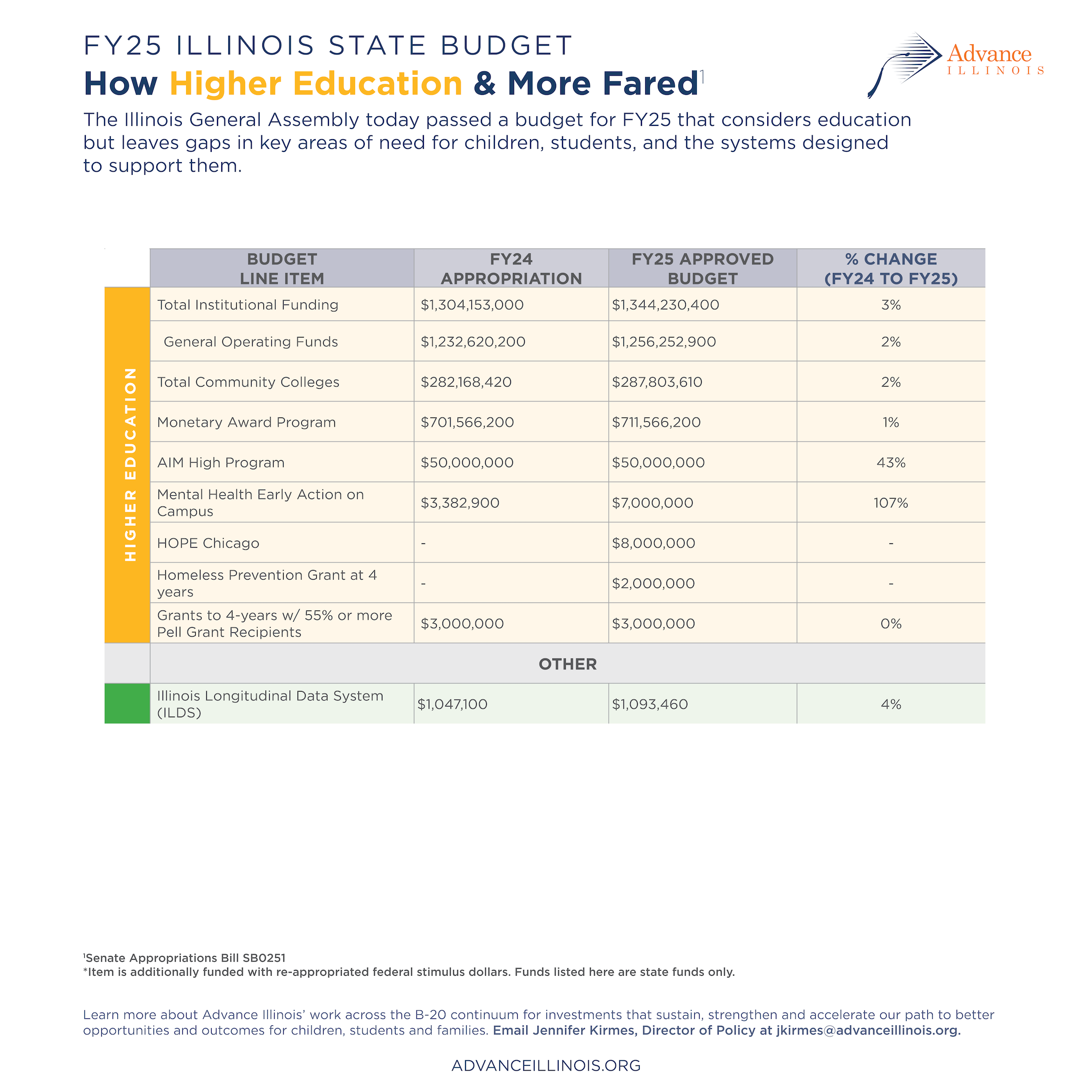From The Desk—On the 2024 Spring Legislative Session: New Beginnings and Important Work Ahead
Last week, the Spring Session of the 103rd General Assembly adjourned, and there are wins to celebrate and opportunities to discuss! Early childhood education was a clear area of focus for lawmakers this session. The state now has a dedicated Department of Early Childhood (SB1), and the Governor’s Smart Start program continues to grow and deepen. But while there is much to celebrate in early childhood, Illinois missed some key opportunities in the K-12 and educator pipeline spaces, both legislatively and budgetarily, and much work remains before Illinois has adequate, equitable, and stable funding for higher education. Below we spotlight some key outcomes, and urge stakeholders to keep fighting for the education system our students deserve.
FY25 Budget Implications
As we shared in our initial statement, the FY25 budget addresses some major educational priorities, even as it left some important work undone. As expected, it was a challenging budget year, and increases to education spending overall did not keep pace with FY24. That said, the FY25 budget makes plain that the Governor and General Assembly continue to prioritize education. More than $700 million new education dollars were added to the budget, and a huge shout out to the Funding Illinois’ Future Coalition, the Minority Teachers of Illinois champions, the We, The Village Coalition, the Coalition for Transforming Higher Education Funding, and the many advocates who raised their voices to keep these priorities top of mind for lawmakers throughout the session!
One challenge posed in this year’s budget was the looming expiration of federal ESSER dollars, which have been used to fund programs to support students in the wake of COVID, but also to address longstanding issues. Budget deliberations this year marked the first set of tough decisions regarding which programs to continue (or not) with state funds.
ESSER funds are not just leaving state coffers, but district purses, too, all while student outcomes still languish below pre-pandemic levels. Addressing ongoing challenges requires substantial investments in districts. While we are glad to see funds for EBF increase another year and appreciate the General Assembly honoring the state’s commitment to a minimum increase of $350 million, we are disappointed to see another year go by without a more substantial $550 million increase. If we aspire to reach full funding before another generation of students graduates, and if we are serious about redressing the impact of profound school disruptions, and if we want to acknowledge the reality that a skipped year of EBF (in FY21) and inflation have challenged school budgets, then we must work that much harder to increase the pace of investment.
Relatedly, it is good to see increased funding of $32.7 million in mandated categoricals, which provide support for critical K-12 expenses outside of EBF. That said, the increase was below what ISBE requested, and most of these categoricals remain significantly prorated. Underfunding of these line items places yet another strain on districts' budgets, and forces districts to divert other sources of funds, like EBF dollars, to cover essential costs like transportation and special education services. Put differently, when we shortchange these categoricals, it erodes the positive impact of EBF. Moving forward, this is an area for attention and action. In a bright spot, however, the General Assembly took action to ensure that reimbursements for high-cost special education services will be equally accessible to districts that place students in public settings as in private (previously, reimbursements were significantly higher for students placed in private settings).
Legislative Highlights
The General Assembly managed an extraordinary volume of education-related bills this year. Here are a few highlights:
Forward-looking Structural Changes in Early Childhood
The establishment of a new Department of Early Childhood (SB1) sets Illinois up for a once-in-a-lifetime opportunity to re-imagine its system of early childhood programs and services so that the state can better meet the needs of families and communities. The bill wisely sets up a two-year transition period for planning and infrastructure development. Programs and services will remain at their legacy agencies until July 1, 2026, allowing the transition team to engage thoughtfully with stakeholders – families, providers, and agencies - on how best to improve the current system.
In another important structural change, language in the Budget Implementation Bill (also known as the BIMP) updates the Early Childhood Access Consortium for Equity (ECACE) Act and codifies the ECACE scholarship. The Consortium was established to dramatically grow and upskill the early childhood workforce – an effort that is essential to growing and strengthening access to early learning. ECACE is a collective of 62 Illinois higher education institutions working together to increase access, persistence, and completion of credentials and degrees for the early childhood workforce. The scholarship provides direct and essential financial support to members of the incumbent early childhood education workforce who are seeking additional degrees and credentials to improve their practice and earning power. While the appropriation for the scholarship was much smaller than hoped for or needed, the scholarship’s addition to statute sets this critical work up for longer-term sustainability.
Support for the Educator Pipeline
Session began with a flurry of bills aimed at addressing educator shortages, and Speaker Emmanuel “Chris” Welch even formed a working group of legislators to attend to the issue. As the session gaveled to a close, however, only a few bills passed both chambers. HB5057 makes three relevant changes: adjusting the timing of the content test requirement such that teachers must pass it prior to licensure rather than prior to student teaching; taking steps towards allowing composite scoring or ‘super scoring’ on content tests (to allow candidates to combine their highest subsection scores earned across multiple takes); and extending the sunset on the Performance Evaluation Advisory Committee, ensuring that the committee can absorb and discuss findings from an evaluation of Illinois’ teacher evaluation system that has been over a year in the making. SB463 also passed both chambers, making technical changes that allow teachers with renewable CTE licenses to be eligible for tenure, and extending the Teacher Performance Assessment Task Force, to give the group more time to complete its recommendations.
At the same time, there were also some missed opportunities. If passed, HB5455 would have allowed community colleges to apply to offer post-baccalaureate initial licensure programs, increasing availability and affordability to programs statewide. We are also disappointed that a bill designed to better support our state’s student teachers stalled in the Senate, after passing the House by wide margins. HB4652 proposed to create a program that would (a) provide stipends to student teachers, reducing inequitable financial barriers into the profession, and (b) provide stipends and training to cooperating teachers to strengthen this critical role. There was a tremendous amount of energy around this bill this session, and we are confident the conversation about how we can best support student teachers will continue.
These developments come as the state continues to grapple with ongoing shortages, and with the need to better support teachers who are being moved into classrooms on provisional licenses or short-term approvals. In a world where support for new teachers and principals is at an all-time high, it was disappointing that new teacher and principal mentoring, vital programs started with ESSER funds that directly target teacher retention issues that persist in our pipeline did not receive any state funds this year. We know state leaders care about developing a world-class educator pipeline, and we hope that ISBE can and will find ways to keep these critical programs.
Adequate, Equitable and Stable Higher Education Funding
In a lean budget year, the state made more modest headway in expanding investment in higher education. State support for Illinois’ signature need-based financial aid program (Monetary Assistance Program) grew by a spare 1%, though projections suggest that will allow the state to meet all need and even increase annual awards a bit. Investment in public universities and community colleges increased by 2%. This more subdued increase likely reflects both budget realities, and the fact that the state has not yet adopted a funding formula that recognizes what each institution needs in order to fairly support its mission and its unique student population. This spring, the Commission on Equitable Public University Funding released a powerful blueprint for reimagining how Illinois funds its universities. Importantly, the report spurred robust subject matter hearings in both the Senate and the House, and we expect a bill to be filed and negotiated. Over the next several months we stand ready to dig in with partners, students, civil rights organizations, and higher education stakeholders from across the state to move forward with urgency and deliberation. As even those who benefit most from the status quo have acknowledged, we simply cannot continue to fund higher education the way we do now – without an understanding of what institutions and students need, and without a way to direct new dollars where they are needed most.
Conclusion
All told, this session was marked by a budget that reflected and prioritized students and by some significant legislative changes that set us up for a better future, especially in early childhood. It is worth pausing to appreciate all those involved in these accomplishments, and worth celebrating the General Assembly’s efforts to continue supporting the next generation, despite very real fiscal pressures. Nonetheless, it is clear that much work remains, and we cannot rest. Looking ahead, even more will be required of us as we struggle to move from recovery to renewal and face ongoing budget realities. We must work together to keep students and all those who support, educate, and inspire them as our top priority. Let us take this opportunity to re-commit ourselves to the important work ahead.
In partnership,
Robin
FY25 Illinois Statement Budget: How Education in Our State Fared
View the following budget area infographics from early childhood to higher education.





